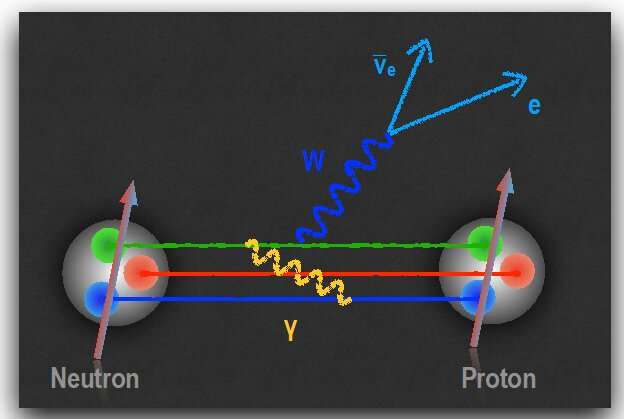
Outside atomic nuclei, neutrons are unstable particles, with a lifetime of about fifteen minutes. The neutron disintegrates due to the weak nuclear force, leaving behind a proton, an electron, and an antineutrino. The weak nuclear force is one of the four fundamental forces in the universe, along with the strong force, the electromagnetic force, and the gravitational force.
Comparing experimental measurements of neutron decay with theoretical predictions based on the weak nuclear force can reveal as-yet undiscovered interactions. To do so, researchers must achieve extremely high levels of precision. A team of nuclear theorists has uncovered a new, relatively large effect in neutron decay that arises from the interplay of the weak and electromagnetic forces.
This research identified a shift in the strength with which a spinning neutron experiences the weak nuclear force. This has two major implications. First, scientists have known since 1956 that due to the weak force, a system and one built like its mirror image do not behave in the same way. In other words, mirror reflection symmetry is broken. This research affects the search for new interactions, technically known as “right-handed currents,” that, at very short distances of less than one hundred quadrillionths of a centimeter, restore the universe’s mirror-reflection symmetry. Second, this research points to the need to compute electromagnetic effects with higher precision. Doing so will require the use of future high-performance computers.
A team of researchers computed the impact of electromagnetic interactions on neutron decay due to the emission and absorption of photons, the quanta of light. The team included nuclear theorists from the Institute for Nuclear Theory at the University of Washington, North Carolina State University, the University of Amsterdam, Los Alamos National Laboratory, and Lawrence Berkeley National Laboratory and their results have been published in Physical Review Letters.
The calculation was performed with a modern method, known as “effective field theory,” that efficiently organizes the importance of fundamental interactions in phenomena involving strongly interacting particles. The team identified a new percent-level shift to the nucleon axial coupling, gA, which governs the strength of decay of a spinning neutron. The new correction originates from the emission and absorption of electrically charged pions, which are mediators of the strong nuclear force. While effective field theory provides an estimate of the uncertainties, improving on the current precision will require advanced calculations on Department of Energy supercomputers.
The researchers also assessed the impact on searches of right-handed current. They found that after including the new correction, experimental data and theory are in good agreement and current uncertainties still allow for new physics at a relatively low mass scale.
More information: Vincenzo Cirigliano et al, Pion-Induced Radiative Corrections to Neutron β Decay, Physical Review Letters (2022). DOI: 10.1103/PhysRevLett.129.121801
Journal information: Physical Review Letters
Provided by US Department of Energy

